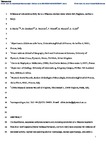Evidence of microbial activity from a shallow water whale fall (Voghera, northern Italy)
| dc.contributor.author | Danise, S | |
| dc.contributor.author | Cavalazzi, B | |
| dc.contributor.author | Dominici, S | |
| dc.contributor.author | Westall, F | |
| dc.contributor.author | Monechi, S | |
| dc.contributor.author | Guioli, S | |
| dc.date.accessioned | 2015-05-01T14:13:43Z | |
| dc.date.available | 2015-05-01T14:13:43Z | |
| dc.date.issued | 2012-02 | |
| dc.identifier.issn | 0031-0182 | |
| dc.identifier.issn | 1872-616X | |
| dc.identifier.uri | http://hdl.handle.net/10026.1/3336 | |
| dc.description.abstract |
The fossil bones, associated carbonate cements and enclosing concretion of a Miocene mysticete from inner shelf deposits (Monte Vallassa Formation, northern Italy) were analyzed for evidence of microbial activity. Optical and scanning electron microscopy, Raman spectroscopy, and stable C and O isotope geochemistry were used for high spatial resolution microfacies and biosedimentological analyses. Whale cancellous bones were filled by different carbonate cements including microcrystalline dolomite, rhombohedral dolomite and sparry calcite. Biofabric and biominerals such as microbial peloids, clotted textures and pyrite framboids were associated with the dolomite cements. Dolomite inside cancellous bones and in the enclosing concretion showed similar isotopic values (avg δ 13C: -7.12‰; avg δ 18O: +3.81‰), depleted with respect to the (late) sparry calcite cement (avg δ 13C: -0.55‰; avg δ 18O: -0.98‰). Microcrystalline barite (BaSO 4) was observed on the external surface of the bones. In addition, two different types of microborings were recognized, distinguished by their size and morphology and were ascribed respectively to prokaryote and fungal trace makers. Our results testify for the development of a diverse microbial ecosystem during the decay of a shallow water whale carcass, which could be detected in the fossil record. However, none of the observed biosignatures (e.g., microbial peloids, clotted textures) can be used alone as a positive fossil evidence of the general development of a sulfophilic stage of whale fall ecological succession. The occurrence of the hard parts of chemosynthetic invertebrates associated with fossil whale bones is still the more convincing proof of the development of a sulfide-base chemoautotrophic ecosystem. © 2011 Elsevier B.V. | |
| dc.format.extent | 13-26 | |
| dc.language | en | |
| dc.language.iso | en | |
| dc.publisher | Elsevier BV | |
| dc.subject | Whale fall | |
| dc.subject | Microbial activity | |
| dc.subject | Carbonate biofabrics | |
| dc.subject | Microborings | |
| dc.title | Evidence of microbial activity from a shallow water whale fall (Voghera, northern Italy) | |
| dc.type | journal-article | |
| dc.type | Article | |
| plymouth.volume | 317-318 | |
| plymouth.publication-status | Published | |
| plymouth.journal | Palaeogeography, Palaeoclimatology, Palaeoecology | |
| dc.identifier.doi | 10.1016/j.palaeo.2011.12.001 | |
| plymouth.organisational-group | /Plymouth | |
| dc.identifier.eissn | 1872-616X | |
| dc.rights.embargoperiod | Not known | |
| rioxxterms.versionofrecord | 10.1016/j.palaeo.2011.12.001 | |
| rioxxterms.licenseref.uri | http://www.rioxx.net/licenses/all-rights-reserved | |
| rioxxterms.type | Journal Article/Review |


